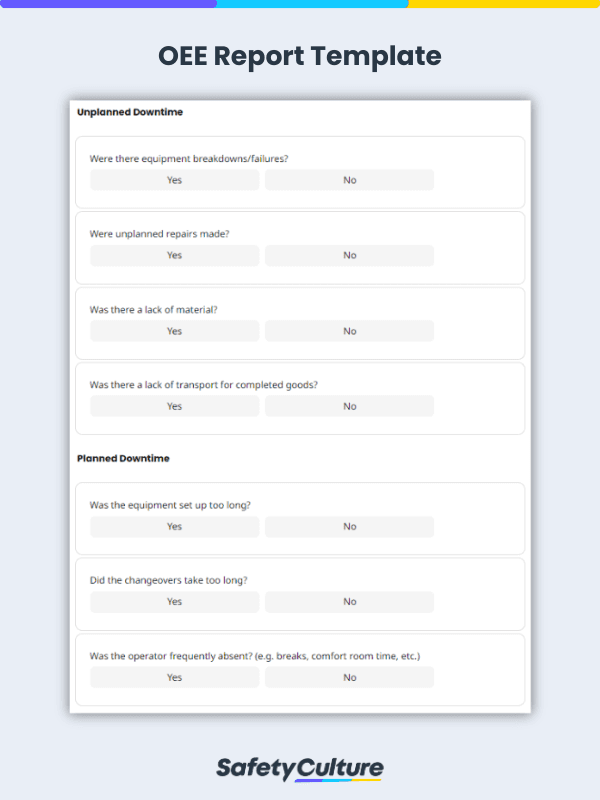What is an OEE Report?
An Overall Equipment Effectiveness (OEE) Report details the availability, performance, and quality of output of a given piece of equipment and its corresponding production process. Manufacturers use the OEE report as a diagnostic tool for locating the source of inefficiencies in their operations. Quality managers should report overall equipment effectiveness on a regular basis to gain insight on process improvement and boost manufacturing productivity.
Tracking and recordkeeping of paper-based OEE reports can be a tedious task for quality managers in manufacturing facilities. Using mobile-ready OEE report templates can help easily identify causes of lost production, monitor overall equipment effectiveness, and enhance output capability and product quality.
5 Simple Ways to Minimize the Six Big Losses
The greatest hindrance to increasing overall equipment effectiveness is the Six Big Losses—unplanned downtime (equipment failure), planned downtime (setup and adjustments), small stops (idling and minor stops), slow cycles (reduced speed), production rejects (process defects and rework), and start-up rejects (reduced yield). Here are 5 simple ways quality managers, cross-functional teams, and upper management can minimize the Six Big Losses:
- Observe breakdown patterns
Availability is one of the three factors that determine overall equipment effectiveness. If equipment failure recurs, production time is lost and quality output is decreased. Quality managers should regularly record breakdown incidents, analyze when they most frequently occur, and identify their root cause(s). Seeing real-time data and actionable insights provides quality managers and upper management the visibility needed to make wise business decisions and achieve operational excellence. - Maximize scheduled downtime
During planned equipment maintenance, manufacturing technicians should also perform cleaning, calibration, and tooling adjustment. Quality managers should consider what continuous improvement activities they can do such as a 5S Audit, Gemba Walk, etc. Scheduling quality inspections during planned downtime helps redeem production time while ensuring the manufacturing process produces conforming, safe, and quality products. - Empower machine operators
When the equipment works but manufactures output at a slower rate than expected, wrong machine settings and a manufacturing process-caused bottleneck could be the culprit in holding up production. Empower machine operators with a digital checklist app to easily follow correct machine operation and start-up and shut-down procedures, document minor stops, and mitigate idling. Enable manufacturing technicians to completely, accurately, and efficiently perform equipment maintenance with a digitized machine maintenance checklist. - Improve workplace practices
Most performance losses (speed losses) occur because of the lack of investment in machines and poor maintenance planning. Cross-functional teams, including upper management, should assess equipment investment plans, production volume, and cost using an OEE manufacturing checklist. For every failed response to questions such as “Is equipment closely monitored in the start-up stages?” and “Are plant assets properly managed?”, assign corrective actions to immediately address quality issues, improve workplace practices, and build a culture of accountability. - Automate manual tasks
Scrap or damaged products during normal production or due to adjustments made during start-up can be prevented when manufacturers streamline quality monitoring checks. Accessing quality assurance inspection forms anywhere, any time, and on any iOS, Android, and Windows mobile device allows manufacturing personnel to save time checking products and preparing reports. Quality managers should also take advantage of a mobile-ready OEE report template for a more efficient collection of data on overall equipment effectiveness.



